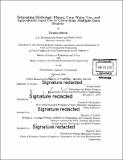Estimating hydrologic fluxes, crop water use, and agricultural land use in China from multiple data sources
Author(s)
Smith, Tiziana
DownloadFull printable version (15.08Mb)
Other Contributors
Technology and Policy Program.
Advisor
Dennis B. McLaughlin.
Terms of use
Metadata
Show full item recordAbstract
Crop production has significantly altered the terrestrial environment by changing land use (Ramankutty et al., 2008) and by altering the water cycle through both co-opting rainfall and surface water withdrawals (Postel et al., 1996). As the world's population continues to grow and individual diets become more resource-intensive, the demand for food - and the land and water necessary to produce it - will continue to increase. Quantitative data about water availability, water use, and agricultural land use are needed to develop sustainable water and agricultural planning and policies. However, existing large-scale data are susceptible to errors and can be physically inconsistent. China is an example of a large area where food demand is expected to increase and a lack of data clouds the resource management dialogue. Some assert that China will have insufficient land and water resources to feed itself, posing a threat to global food security if they seek to increase food imports (Brown and Starke, 1995). Others believe resources are plentiful (Lomborg, 2001). Without quantitative data, it is difficult to discern if these concerns are realistic or overly dramatized. This thesis presents a quantitative approach to characterize hydrologic fluxes, crop water use, and agricultural land use and applies the methodology in China using data from around the year 2000. The approach uses the principles of water balance and of crop water requirements to assimilate existing data with a least-squares estimation technique, producing new estimates of water and land use variables that are physically consistent while minimizing differences from measured data. We argue that this technique for estimating water fluxes and agricultural land use can provide a useful basis for resource management and policy, both in China and around the world.
Description
Thesis: S.M., Massachusetts Institute of Technology, Department of Civil and Environmental Engineering, 2016. Thesis: S.M. in Technology and Policy, Massachusetts Institute of Technology, Institute for Data, Systems, and Society, Technology and Policy Program, 2016. Cataloged from PDF version of thesis. Includes bibliographical references (pages 95-99).
Date issued
2016Department
Massachusetts Institute of Technology. Department of Civil and Environmental Engineering; Massachusetts Institute of Technology. Engineering Systems Division; Massachusetts Institute of Technology. Institute for Data, Systems, and Society; Technology and Policy ProgramPublisher
Massachusetts Institute of Technology
Keywords
Civil and Environmental Engineering., Institute for Data, Systems, and Society., Engineering Systems Division., Technology and Policy Program.